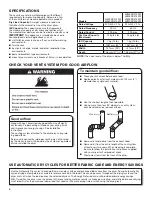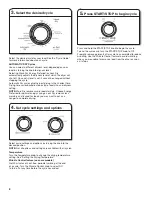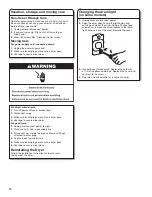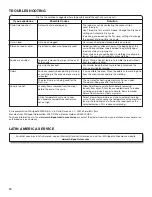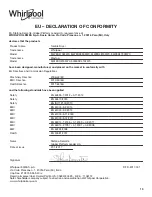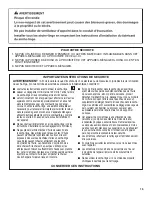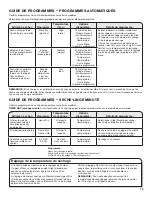
15
POUR VOTRE SECURITE
1. NE PAS UTILISER OU REMISER D’ESSENCE OU AUTRES MATÉRIAUX INFLAMMABLES DANS CET
APPAREIL MÉNAGER O U À PROXIMITÉ DE CELUI-CI.
2. NE PAS VAPORISER D’AÉROSOLS À PROXIMITÉ DE CET APPAREIL MÉNAGER LORSQU’IL EST EN
FONCTIONNEMENT.
3. NE PAS MODIFIER CET APPAREIL MÉNAGER.
IMPORTANTES INSTRUCTIONS DE SECURITE
AVERTISSEMENT :
Afin de réduire le risque d’incendie, de choc électeiue ou de blessures corporellles lors de l’utilisation
du sèche-linge, il convient d’observer certaines précautions fondamentales, notamment :
CONSERVER CES INSTRUCTIONS
n
Lire toutes les instructions avant d’utiliser le sèche-linge.
n
Laisser un dégagement minimal de 100 mm (4") entre l’arrière
du sèche-linge et les éventuelles parois environnantes.
n
Le fonctionnement de cet appareil peut affecter celui d’autres
appareils dont la source d’approvisionnement en air se fait
dans la même pièce pour une combustion sans danger.
Lorsqu’on utilise le sèche-linge, une aération adéquate est
nécessaire pour renouveler l’air rejeté et ainsi éviter le retour
dans la pièce de gaz en provenance d’appareils ménagers
utilisant d’autres carburants comme combustible, y compris
les feux ouverts. En case de doute, consulter le fabricant
de l’appareil.
n
Ne pas obstruer l’alimentation en air du sèche-linge (voir les
instructions d’installation pour les dégagements minimaux).
n
Ne pas placer d’articles tâchés d’huile de cuisson dans
le sèche-linge. Des articles ayant été au contact d’huile
peuvent d’enflammer spontanément, surtout s’ils sont
exposés à des sources de chaleur, telles un sèche-linge.
Les articles peuvent chaufer, entraînant une réaction
d’oxydation de l’huile. Le phénomène d’oxydation crée
de la chaleur. Si la chaleur ne peut pas s’échapper, les
articles peuvent devenir suffisamment chauds pour prendre
feu. Le fait d’empiler, d’entasser ou d’entreposer des articles
ayant été au contact d’huile peut empêcher la chaleur
de s’échapper et créer un risque d’incendie.
4
IMPORTANT SAFETY INSTRUCTIONS
precautions, including the following:
WARNING:
Read all instructions before using the dryer.
Keep a minimum clearance of 100 mm (4 in.) between the
rear of the dryer and any wall.
The operation of this appliance may affect the operation of
other types of appliances which take their air supply for safe
combustion from the same room. There has to be adequate
ventilation to replace exhausted air and thus avoid the
back-flow of gases into the room from appliances burning
other fuels, including open fires, when operating the tumble
dryer. If in doubt, consult the appliance manufacturers.
Do not obstruct the air supply to the dryer (see Installation
Instructions for minimum clearances).
Do not place items exposed to cooking oils in your dryer.
Oil-affected items can ignite spontaneously, especially when
exposed to heat sources such as in a tumble dryer. The
items become warm causing an oxidation reaction in the oil.
Oxidation creates heat. If the heat cannot escape, the items
can become hot enough to catch fire. Piling, stacking or
storing oil-affected items can prevent heat from escaping
and so create a fire hazard.
If it is unavoidable to dry in the dryer items that have been
soiled with substances such as cooking oil, acetone, alcohol,
petrol, kerosene, spot removers, turpentine, waxes and wax
removers, or that have been contaminated by hair care
products, should be washed in hot water with an extra
amount of detergent before being dried in the dryer. These
items may give off vapours that could ignite or explode. Such
washing will reduce, but not eliminate, the hazard.
This appliance is not intended for use by persons (including
children) with reduced physical, sensory or mental
capabilities, or lack of experience and knowledge, unless
they have been given supervision or instructions concerning
use of the appliance by persons responsible for their safety.
Children should be supervised to ensure that they do not
play with the appliance.
The dryer should not be used if industrial chemicals have
been used for cleaning.
Before the dryer is removed from service or discarded,
remove the doors to the drying compartment.
Do not reach into the dryer if the drum is moving. A door
switch is fitted for your safety.
Do not install or store the dryer where it will be exposed
to the weather.
Do not tamper with controls.
Do not continue to use this appliance if it appears to be
faulty.
Do not repair or replace any part of the dryer or attempt
any maintenance unless specifically recommended in this
Use and Care Guide. Repairs and servicing should only
be carried out by competent service personnel.
Do not use fabric softeners or products to eliminate static
unless recommended by the manufacturer of the fabric
softener or product. Follow their instructions.
Clean dryer lint screen before or after each load. Do not
operate dryer without lint screen in place.
Keep area around the exhaust and inlet openings and
adjacent surrounding areas free from the accumulation of
lint, dust, and dirt.
The interior of the dryer and exhaust vent should be
cleaned periodically by qualified service personnel.
See Installation Instructions for earthing instructions.
Do not dry unwashed items in this dryer.
Items such as foam rubber (latex foam), shower caps,
waterproof textiles, rubber backed articles and clothes or
pillows fitted with foam rubber pads must only be dried
on a clothesline.
SAVE THESE INSTRUCTIONS
WARNING:
Never stop a tumble dryer cycle before the
end of the drying cycle unless all items are quickly removed
and spread out so that the heat is dissipated.
To reduce the risk of fire, electric shock, or injury to persons when using the dryer, follow basic
The final part of a tumble dryer cycle occurs without heat
(cool down cycle) to ensure that the items are left at a
temperature that ensures the items will not be damaged.
If the supply cord is damaged, it must be replaced by the
manufacturer or its service agent or a similarly qualified
person in order to avoid a hazard.
n
Si l’on doit faire sécher dans le sèche-linge des articles
ayant été souillés par des substances telles que de l’huile
de cuisson, acétone, alcool, pétrole, kérosène, produit
détachant, térébenthine, cire, décapant pour cire ou produits
de coiffure, ils doivent être lavés à l’eau chaude avec un
supplément de détergent avant d’être séchés dans le sèche-
linge. Ces articles sont susceptibles de dégager des vapeurs
qui pouraient s’enflammer ou exploser. Les laver ainsi
au préalable permet de réduire mais non de supprimer
ce risque.
n
Cet appareil ne convient pas à une utilisation par des
personnes (y compris des enfants
de moins de 8 ans)
à capacités physiques, sensorielles ou mentales réduites,
ou dépourvues d’expérience et de connaissances, à moins
qu’elles ne soient placées sous supervision ou qu’elles aient
reçu des instructions concernant l’utilisation de l’appareil
par une personne responsable de leur sécurité.
n
Les enfants qui effectuent le nettoyage et l'entretien doivent
être supervisés.
n
Il convient de surveiller les enfants pour qu’ils ne jouent pas
avec l’appareil.
n
Les enfants de moins de 3 ans ne doivent pas se trouver
à proximité de l’appareil à moins d’être constamment
surveillés.
n
Ne pas utiliser le sèche-linge si l’on a utilisé des produits
chimiques industriels pour le nettoyage.




